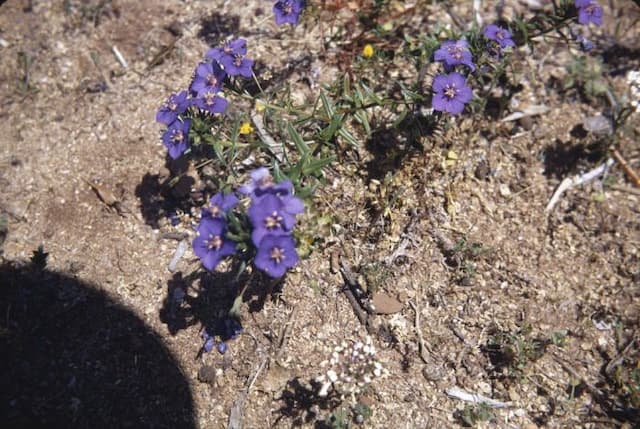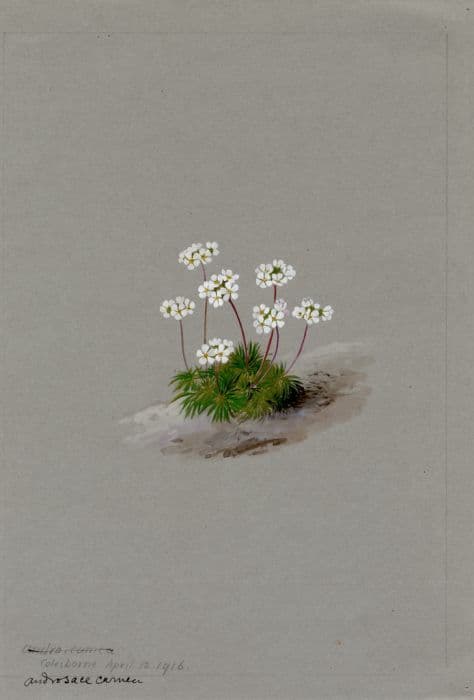Ivy-leaved cyclamen Cyclamen hederifolium

ABOUT
Cyclamen hederifolium, commonly known as ivy-leaved cyclamen or sowbread, is a perennial flowering plant. It is recognized for its beautiful and distinctive flowers that blossom above the ground in shades of pink and sometimes white. Each flower has a unique shape, featuring upswept petals that are reflexed, giving the appearance of a hovering butterfly. The leaves of Cyclamen hederifolium are equally attractive and contribute to the plant's ornamental value. They emerge from the ground on long stalks and are variegated in patterns of green and silver. The leaf shape resembles that of ivy leaves, hence the common name, with a heart or kidney shape that is often lobed or angled. When not in flower, the foliage alone provides visual interest with the intricate leaf patterns and the diverse array of green and silvery hues. The leaves form a low-growing, attractive mound, which persists through winter in milder climates. The plant also produces a tuber, which rests below the soil surface. This tuber is an essential part of the plant, as it stores energy and nutrients allowing the cyclamen to survive through adverse conditions and return year after year with renewed growth and blooms.
About this plant
 Names
NamesFamily
Primulaceae
Synonyms
Ivy-leaved Cyclamen, Sowbread
Common names
Cyclamen neapolitanum, Cyclamen hederifolium var. confusum, Cyclamen hederifolium var. poli, Cyclamen hederifolium subsp. crassifolium, Cyclamen hederifolium var. album, Cyclamen hederifolium var. rubrum, Cyclamen hederifolium var. crassifolium.
 Toxicity
ToxicityTo humans
The Cyclamen, specifically Cyclamen hederifolium, contains toxic compounds such as saponins that can cause poisoning if any part of the plant is ingested. The symptoms of cyclamen poisoning in humans can include vomiting, diarrhea, and abdominal pain. In severe cases, ingestion can lead to heart rhythm abnormalities, seizures, and even death, although such extreme reactions are rare. It is particularly important to keep young children away from cyclamen plants, as they might be tempted by their attractive appearance.
To pets
The Cyclamen plant is toxic to pets, including cats and dogs, due to the presence of saponins. Pets that ingest any part of the plant, especially the tubers which have the highest concentration of these toxic compounds, can experience symptoms such as vomiting, diarrhea, excessive drooling, and appetite loss. In severe cases, cyclamen ingestion can lead to heart problems, seizures, and potentially be fatal. Therefore, it is crucial to prevent pets from having access to cyclamen plants.
 Characteristics
CharacteristicsLife cycle
Perennials
Foliage type
Deciduous
Color of leaves
Variegated
Flower color
Pink
Height
6 inches (15 cm)
Spread
6 inches (15 cm)
Plant type
Bulb
Hardiness zones
5
Native area
Mediterranean
Benefits
 General Benefits
General Benefits- Decorative Appeal: The plant offers vibrant pink and white flowers that add aesthetic beauty to gardens and indoor spaces.
- Attracts Pollinators: Cyclamen hederifolium flowers can attract butterflies and bees, which is beneficial for plant pollination.
- Seasonal Interest: It provides color and interest in the garden during late summer and autumn when many other plants have finished blooming.
- Drought Tolerance: Once established, it is relatively drought-tolerant, making it suitable for dry or xeriscaped gardens.
- Low Maintenance: Requires little care once it has settled in, making it a convenient choice for busy gardeners.
- Compact Growth: Its small size and compact growth habit make it suitable for rock gardens, borders, or containers.
- Shade Tolerant: The plant can thrive in partially shaded areas, offering gardeners a flowering option for darker spots in the garden.
- Naturalizing: Cyclamen hederifolium can spread and naturalize in suitable conditions, creating swathes of color.
- Seasonal Foliage: Its heart-shaped, marbled leaves provide visual interest even when the plant is not in flower.
- Cold Hardy: The plant is resistant to cold and can survive in cooler climates, making it a resilient choice for gardens in temperate zones.
 Medical Properties
Medical PropertiesThis plant is not used for medical purposes.
 Air-purifying Qualities
Air-purifying QualitiesThis plant is not specifically known for air purifying qualities.
 Other Uses
Other Uses- Cyclamen hederifolium tubers can be used to produce a laundry soap substitute. When crushed, they create a soapy lather that can be used for washing clothes.
- The flowers of Cyclamen hederifolium, due to their delicate appearance, are sometimes used in floral arrangements and as wedding decorations for their aesthetic beauty.
- The plant's ability to grow in shady areas makes it perfect for underplanting under trees or shrubs in gardens, providing ground cover and enhancing the visual appeal of garden beds.
- With its attractive foliage and winter blooms, Cyclamen hederifolium is also used for naturalizing in woodland settings, creating a charming, fairy-tale-like environment as it spreads.
- The dried and powdered tuber of Cyclamen hederifolium has historically been used as a detergent for cleaning paintings and textiles, being gentle on the materials.
- In some cultures, the boiled tubers of Cyclamen hederifolium were once used to make a paste for polishing silver and other metals, giving them a bright, clean finish.
- The plant can play a role in companion planting, serving as a decoy for pests that might otherwise attack nearby valuable crops or ornamental plants.
- The ornamental value of Cyclamen hederifolium extends to container gardening, where its heart-shaped leaves and flowers can thrive in pots and window boxes, brightening up balconies and patios.
- Because the flowers close at night and reopen in the morning, Cyclamen hederifolium can be used in educational settings to teach children about plant behaviors and rhythms.
- The seeds of Cyclamen hederifolium are a food source for ants, which help disperse them through a process known as myrmecochory. This symbiotic relationship can be useful in ecological studies or conservation work.
Interesting Facts
 Feng Shui
Feng ShuiThe Cyclamen is not used in Feng Shui practice.
 Zodiac Sign Compitability
Zodiac Sign CompitabilityThe Cyclamen is not used in astrology practice.
 Plant Symbolism
Plant Symbolism- Deep Love: Cyclamen, often given as a token of deep, lasting affection, represents feelings that are profound and heartfelt.
- Goodbye: In the language of flowers, giving someone cyclamen can imply a parting or a gentle farewell, signaling the end of a relationship or a sense of closure.
- Sincerity: The cyclamen is sometimes used to convey sincere emotions and genuine concern for others.
- Shyness: The delicate and graceful form of the cyclamen can symbolize timidity or shyness, suggesting a reserved love or affection.
 Water
WaterFor the Ivy-leaved Cyclamen, water sparingly during active growth by moistening the topsoil only when it feels dry to the touch. Typically, this might require watering with about 1 to 2 ounces per plant every week, depending on the climate and indoor conditions. Avoid watering directly into the crown of the plant as this can lead to rot. Reduce watering during the plant's dormant period in the summer, and resume regular watering as the cooler weather returns and new growth appears in autumn. Always ensure good drainage to prevent water from pooling at the bottom of the container.
 Light
LightIvy-leaved Cyclamen thrives in bright, indirect light. It's best positioned in a north or east-facing window where it can receive gentle morning light or diffused afternoon light. Avoid placing the plant in direct sunlight, especially during the hot summer months, as this can scorch the leaves and flowers.
 Temperature
TemperatureThe ideal temperature range for Ivy-leaved Cyclamen is between 50°F and 68°F. They can withstand a temporary dip as low as 40°F but should not be exposed to temperatures below this, as it can cause damage or death to the plant. They are not suited for extended exposure to temperatures above 68°F, which can inhibit blooming and lead to dormancy.
 Pruning
PruningIn the case of Ivy-leaved Cyclamen, pruning is mainly about removing yellowing or dead leaves and spent flowers to encourage further blooming and maintain a tidy appearance. The best time to prune is right after the blooms fade. Trimming back the foliage after it starts to die back naturally, typically in late spring as the plant enters dormancy, will help to encourage vigorous growth when the plant becomes active again in the fall.
 Cleaning
CleaningAs needed
 Soil
SoilCyclamen hederifolium, commonly known as ivy-leaved cyclamen, thrives in a well-draining soil mix composed of 1 part potting soil, 1 part perlite, and 1 part leaf mold or fine bark to mimic its natural woodland habitat. The best soil pH for this plant is slightly acidic to neutral, ranging from 6.0 to 7.5.
 Repotting
RepottingIvy-leaved cyclamen should be repotted every couple of years or when it becomes pot-bound. Generally, repotting is done in late summer before the onset of the growing season, but disturbing the roots as little as possible is key to avoid shock.
 Humidity & Misting
Humidity & MistingIvy-leaved cyclamen prefers moderate to high humidity levels, around 50-70%. Avoid placing it in excessively dry environments, as cyclamen are adapted to the humid conditions of their native Mediterranean habitats.
 Suitable locations
Suitable locationsIndoor
Keep ivy-leaved cyclamen in bright, indirect light indoors with cool temperatures.
Outdoor
Plant ivy-leaved cyclamen in dappled shade outside, well-drained soil.
Hardiness zone
5-9 USDA
 Life cycle
Life cycleCyclamen hederifolium, also known as ivy-leaved cyclamen or sowbread, begins its life cycle when the seeds germinate in late spring, after a period of dormancy through the winter. As the temperatures rise, the seedlings develop a tuber, which acts as a storage organ. From this tuber, heart-shaped leaves with silver and green marbling emerge in late summer to early fall, indicating the vegetative growth stage. The leaves are followed by flowering, occurring from late summer to autumn, where pink to purplish flowers with a distinctive reflexed petal shape appear. After pollination, often by insects, the flowers give way to seed pods which ripen and are eventually drawn underground by the coiling of the stems, where the cycle can begin anew with seed dispersal. In the winter, the plant goes dormant, shedding its leaves, and relies on the tuber to survive until the next growing season.
 Propogation
PropogationPropogation time
Autumn to spring
The most popular method of propagating Cyclamen hederifolium, commonly known as the ivy-leaved cyclamen, is through seed sowing. Seed collection occurs after the flowers have finished blooming and the seed pods have ripened, typically from late summer to early fall. Fresh seeds germinate more readily, so it's important to sow them soon after harvesting. To propagate by seed, sow the seeds in a tray filled with a free-draining potting mix, and lightly cover them with soil. Keep the tray in a cool place with indirect light and maintain consistent moisture without waterlogging. Germination can be slow and erratic, often taking several weeks to a few months. Once seedlings develop a few true leaves, they can be carefully transplanted into individual pots.









